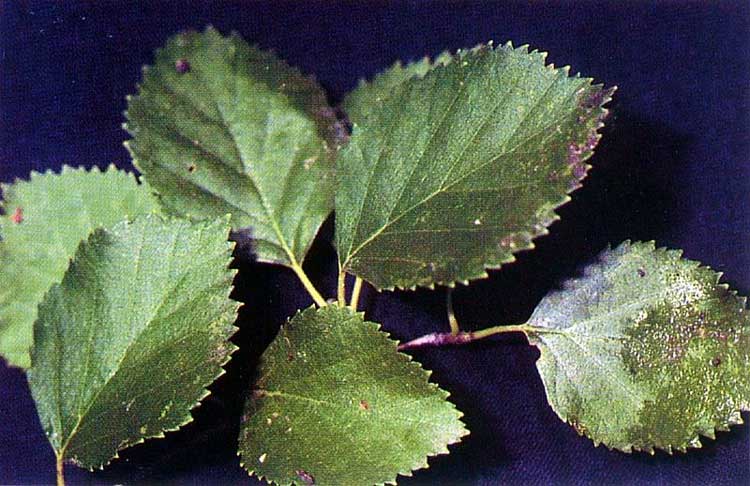
Betula occidentalis, USDA NRCS Plants
Classification System: APG IV
Superregnum: Eukaryota
Regnum: Plantae
Cladus: Angiosperms
Cladus: Eudicots
Cladus: Core eudicots
Cladus: Rosids
Cladus: Eurosids I
Ordo: Fagales
Familia: Betulaceae
Subfamilia: Betuloideae
Genus: Betula
Subgenus: Betula subg. Betula
Sectio: Betula sect. Betula
Species: Betula occidentalis
Name
Betula occidentalis Hook., Fl. Bor.-Amer. 2: 155 (1838).
Synonyms
Homotypic
Betula alba subsp. occidentalis (Hook.) Regel, Bull. Soc. Imp. Naturalistes Moscou 38(2): 400 (1865).
Betula papyracea var. occidentalis (Hook.) Dippel, Handb. Laubholzk. 2: 177 (1891).
Betula alba f. occidentalis (Hook.) Fernald, Amer. J. Sci., ser. 4, 14: 173 (1902).
Betula microphylla var. occidentalis (Hook.) M.E.Jones, Contr. W. Bot. 12: 77 (1908).
Betula papyrifera var. occidentalis (Hook.) Sarg., J. Arnold Arbor. 1: 63 (1919).
Betula papyrifera subsp. occidentalis (Hook.) Hultén, Acta Univ. Lund., 2, 40(1): 582 (1944).
Heterotypic
Betula fontinalis Sarg., Bot. Gaz. 31: 239 (1901).
Betula microphylla var. fontinalis (Sarg.) M.E.Jones, Contr. W. Bot. 12: 77 (1908).
Betula elrodiana E.J.Butler, Bull. Torrey Bot. Club 36: 426 (1909).
Betula fontinalis f. inopina Jeps., Fl. Calif. 1: 349 (1909).
Betula occidentalis f. inopina Jeps., Fl. Calif. 1: 349 (1909).
Betula fontinalis var. inopina (Jeps.) Jeps., Man. Fl. Pl. Calif.: 270 (1923).
Betula beeniana A.Nelson, Amer. J. Bot. 32: 284 (1945).
Betula occidentalis var. inopina (Jeps.) C.L.Hitchc., Vasc. Pl. Pacif. N. W. 2: 78 (1964).
Betula occidentalis subsp. inopina (Jeps.) A.E.Murray, Kalmia 13: 3 (1983).
References
Ashburner, K. & McAllister, H.A. 2013. The genus Betula: A taxonomic revision of birches (A Botanical Magazine Monograph). Royal Botanic Gardens, Kew, 431 pp., ISBN 978-1-84246-141-9. Reference page.
Stritch, L., 2014. Betula occidentalis. The IUCN Red List of Threatened Species 2014. IUCN Red List Category: (Least Concern). DOI: 10.2305/IUCN.UK.2014-3.RLTS.T194643A2355167.en. Reference page.
Wang. N., McAllister, H.A., Bartlett, P.R. & Buggs, R.J.A. 2016. Molecular phylogeny and genome size evolution of the genus Betula (Betulaceae). Annals of Botany 117(6): 1023–1035. DOI: 10.1093/aob/mcw048 Reference page.
Govaerts, R. et al. 2019. Betula occidentalis in World Checklist of Selected Plant Families. The Board of Trustees of the Royal Botanic Gardens, Kew. Published on the internet. Accessed: 2019 February 7. Reference page.
International Plant Names Index. 2019. Betula occidentalis. Published online. Accessed: 7 February 2019.
Vernacular names
Deutsch: Westliche Birke, Wasser-Birke
English: Water Birch
Esperanto: Okcidenta betulo, Fonta betulo
suomi: Jokikoivu
Türkçe: Nehir huşu
Betula occidentalis, the water birch or red birch, is a species of birch native to western North America, in Canada from Yukon east to Northwestern Ontario and southwards, and in the United States from eastern Washington east to western North Dakota, and south to eastern California, northern Arizona and northern New Mexico, and southwestern Alaska. It typically occurs along streams in mountainous regions.[1]
Betula occidentalis trunk (bark) along the Columbia River, Colockum Wildlife Area, Chelan County Washington
It is a deciduous shrub or small tree growing to 10 m (33 ft) high, usually with multiple trunks. The bark is dark red-brown to blackish, and smooth but not exfoliating. The twigs are glabrous or thinly hairy, and odorless when scraped. The leaves are alternate, ovate to rhombic, 1–7 cm (0.39–2.76 in) long and 1–4.5 cm (0.39–1.77 in) broad, with a serrated margin and two to six pairs of veins, and a short petiole up to 1.5 cm (0.59 in) long. The flowers are wind-pollinated catkins 2–4 cm (0.79–1.57 in) long, the male catkins pendulous, the female catkins erect. The fruit is 2–3 cm (0.79–1.18 in) long and 8–15 mm (0.31–0.59 in) broad, composed of numerous tiny winged seeds packed between the catkin bracts.[1][2][3]
The identity of similar birches in Alaska is disputed; some include them in B. occidentalis, while others regard them as hybrids between Betula neoalaskana and Betula glandulosa.[1]
Some Plateau Indian tribes used water birch to treat pimples and sores.[4] The foliage is browsed by sheep and goats.[5]
It has a strong tendency to epicormic growth resulting in a habit of many small limbs sprouting from the trunk causing the wood to be full of small knots.
References
Flora of North America: Betula occidentalis
Plants of British Columbia: Betula occidentalis
Jepson Flora: Betula occidentalis
Hunn, Eugene S. (1990). Nch'i-Wana, "The Big River": Mid-Columbia Indians and Their Land. University of Washington Press. p. 352. ISBN 0-295-97119-3.
Little, Elbert L. (1980). The Audubon Society Field Guide to North American Trees: Eastern Region. New York: Knopf. p. 368. ISBN 0-394-50760-6.
Further reading
Saliendra, NicanorZ.; Sperry, JohnS.; Comstock, JonathanP. (1995). "Influence of leaf water status on stomatal response to humidity, hydraulic conductance, and soil drought in Betula occidentalis". Planta. 196 (2). doi:10.1007/BF00201396. ISSN 0032-0935. S2CID 40158479.
Sperry, J. S.; Pockman, W. T. (1993). "Limitation of transpiration by hydraulic conductance and xylem cavitation in Betula occidentalis". Plant, Cell and Environment. 16 (3): 279–287. doi:10.1111/j.1365-3040.1993.tb00870.x. ISSN 0140-7791.
Sperry, J. S.; Saliendra, N. Z. (1994). "Intra- and inter-plant variation in xylem cavitation in Betula occidentalis". Plant, Cell and Environment. 17 (11): 1233–1241. doi:10.1111/j.1365-3040.1994.tb02021.x. ISSN 0140-7791.
Sperry, John S (2000). "Hydraulic constraints on plant gas exchange". Agricultural and Forest Meteorology. 104 (1): 13–23. doi:10.1016/S0168-1923(00)00144-1. ISSN 0168-1923.
Retrieved from "http://en.wikipedia.org/"
All text is available under the terms of the GNU Free Documentation License


